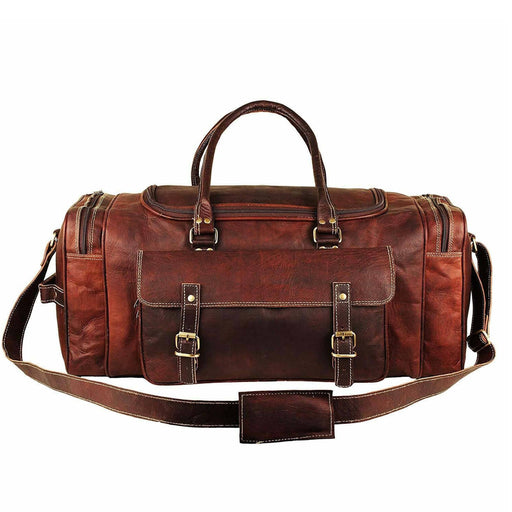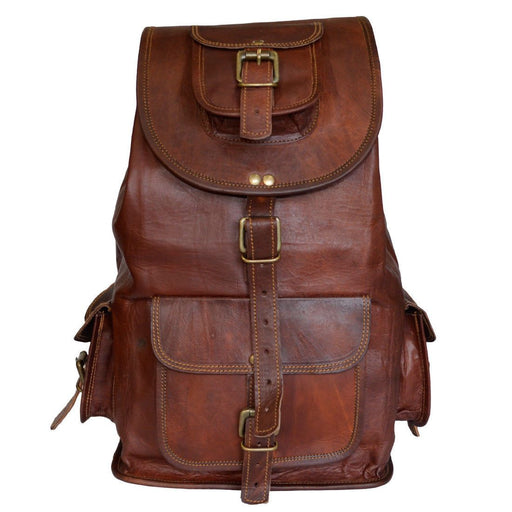
What Is Top Grain Leather? Complete Top Grain Leather Guide
Complete Guide on Top Grain leather
When it comes to timeless accessories made of premium materials such as leather, top-grain leather is one of the best grades of leather and is selected by many premium companies. Top-grain leather is a classic material that develops character and patina over time.
Top grain leather is utilised in a variety of applications, including premium leather bags, coats, belts, shoes, and furniture. In this comprehensive top-grain leather tutorial, we will look at what top-grain leather is and go over its specific qualities, how to pick top-grain leather, how it compares to other types of leather, top-grain leather usage, applications, and more.
What is Top-grain leather?
Top grain leather is made from the top layer of animal skin, which is sanded and polished to eliminate defects and smooth out the leather surface. This buffing eliminates defects but also removes the natural grains of leather, making it significantly less durable than full-grain leather. Top-grain leather keeps part of the natural texture of leather, but because the defects have been buffed out, it has a somewhat more processed appearance and feel.
What is Top-grain leather made of?

Top grain leather can be manufactured from any animal skin, but buffalo and cowhide leather are most commonly used. Top-grain leather may also be produced from other animals such as pigs, goats, deer, and horses. Some exotic leathers are manufactured from alligators, crocodiles, and snakes.
Top-grain leather is made from high-quality calfskin that has been cleaned to remove any dirt, hair, or other impurities. They are then soaked in water to make them simpler to handle.
The hides are then separated into layers; the top layer is used to manufacture top-grain leather, while the bottom layers are utilised to make split leather. To eliminate defects and blemishes, the top grain layer is buffed and sanded. This results in a leather surface that is smooth and even. After processing, the top-grain leather is tanned and dyed to get the desired colour.
Why Choose Top Grain Leather?
Top-grain leather maintains a uniform look throughout the product and is highly durable. It is simple to work with and has an appealing finish after the production process, making top grain leather ideal for most leather luxury items.
Even if you lose any of the leather's natural sheen during treatment, you may reapply it or add any number of designs to personalize the look and feel of top-grain leather. When you buy top grain leather, you receive a very high-quality product for your money, making it a great compromise between genuine leather and full grain leather.
Also Check : What Is Nubuck Leather
Key Features of Top-Grain Leather
Top-grain leather has several distinguishing traits that set it apart from full-grain leather.
- Natural Grainy Pattern: Top grain leather keeps the original grain pattern, making each hide distinctive.
- Smell: Top grain leather has a unique leathery odour that is natural and preferred by many leather enthusiasts. It should not have a chemical or synthetic odour.
- Smooth surface: Top-grain leather has a smooth and uniform surface owing to the removal of flaws and blemishes.
- Durability: Top grain leather, a genuine leather variation, is distinguished by its endurance, consistent look, and protective coating, which increases resistance to wear and tear. However, compared to full-grain leather, which is manufactured from the complete thickness of the animal hide, it is less durable. It scores second on a durability rating when compared to other leather varieties.
- Quality and Longevity: The quality and lifespan of top grain leather goods are determined by the production method, the exact animal hide used, and the care and maintenance provided. Top grain leather items may keep their quality and look for a longer amount of time if properly cared for.
- Waterproofing and Water Resistance: Although top grain leather lacks inherent waterproofing characteristics, using a water-resistant spray or coating can improve its resistance to moisture. However, it is important to note that waterproofing treatments may have an influence on the leather's permeability.
Applications of Top-Grain Leather

Top grain leather is extremely popular and sought due to its durability, beauty, adaptability, and, most importantly, its timeless developing patina. Many high-end things are made from top grain leather, including purses, baggage bags, garments, footwear, leather belts, hats, wallets, leather furniture, automotive interiors, leather sports equipment, and so on.
Also Read : What are the Different types of Leather
How to choose Top-grain leather?
When selecting real top-grain leather, it is necessary to conduct a thorough examination of the leather surface and seek for certain qualities. Our advice below will assist you in selecting the best top-grain leather for your needs.
- Feel the surface: Touch the leather surface of the top grain leather with your fingertips to experience its softness and suppleness. High-quality top-grain leather should be soft, malleable, and sensual to the touch.
- Smell the Leather: Top grain leather should have a unique leathery aroma rather than a chemical or synthetic odour.
- Look for imperfections: Although top-grain leather is treated to remove severe flaws, small defects may still exist. Inspect the leather for scars, scratches, or flaws. It shouldn't be very artificial or synthetic.
- Check the tags and labels: Look for information on the labels indicating the quality and kind of leather, such as top grain leather.
- Seek Expert Help: If you're not sure how to choose the correct top-grain leather, seek guidance from leather specialists or skilled leather dealers. They can give you with vital insights and advice to help you make an educated decision.
Top grain leather vs full grain leather
Although both top-grain and full-grain leather are of great quality, they have different features that must be distinguished by thorough inspection. Let us look at the differences between these two.
|
Feature |
Top Grain Leather |
Full Grain Leather |
|
Definition |
The outer layer of the hide with some surface treatment |
The outermost layer of the hide, unaltered and natural |
|
Appearance |
Smooth surface with fewer natural markings |
Natural texture with visible grains and imperfections |
|
Durability |
Durable but may not be as robust as full grain |
Highly durable and long-lasting |
|
Aging |
Ages well, retains appearance with proper care |
Develops a rich patina over time |
|
Price Range |
Usually less expensive compared to full grain |
Typically more expensive due to quality and rarity |
|
Softness |
Softer and more supple compared to full grain |
Firm and sturdy, becomes softer with use |
|
Common Uses |
Apparel, accessories, upholstery |
High-end bags, footwear, furniture |
|
Maintenance |
Regular conditioning and care recommended |
Requires minimal maintenance, occasional conditioning |
|
Origin |
Also derived from the top layer, with surface treatment |
Derived from the top layer of the hide |

Top-Grain Leather vs Genuine Leather
|
Feature |
Top-Grain Leather |
Genuine Leather |
|
Definition |
The outer layer of the hide with some surface treatment |
Made from layers of low-quality leather |
|
Appearance |
Smooth surface with fewer natural markings |
May have artificial grain or embossing to mimic leather |
|
Durability |
Durable but may not be as robust as full-grain leather |
Less durable and prone to wear |
|
Aging |
Ages well, retains appearance with proper care |
May not age as gracefully |
|
Price Range |
Usually more expensive compared to genuine leather |
Generally more affordable compared to top-grain leather |
|
Softness |
Softer and more supple compared to full-grain leather |
Softer and less firm compared to top-grain leather |
|
Common Uses |
Apparel, accessories, upholstery |
Apparel, accessories, upholstery |
|
Maintenance |
Regular conditioning and care recommended |
Minimal maintenance required |
|
Origin |
Derived from the top layer of the hide with surface treatment |
Made from layers of lower-quality leather |
Top-Grain Leather vs PU Leather
|
Feature |
Top-Grain Leather |
PU Leather |
|
Material |
Derived from animal hides |
Made from polyurethane, a synthetic material |
|
Appearance |
Natural texture with visible grains and imperfections |
Smooth and uniform texture, may mimic leather |
|
Durability |
Highly durable and long-lasting |
Less durable compared to genuine leather |
|
Aging |
Ages well, develops a patina over time |
Does not age or develop patina like real leather |
|
Eco-Friendliness |
Not environmentally friendly, derived from animal hides |
May be more eco-friendly, depending on manufacturing |
|
Price Range |
Typically more expensive than PU leather |
Generally more affordable compared to real leather |
|
Maintenance |
Requires regular conditioning and care |
Easy to clean and maintain with minimal effort |
|
Water Resistance |
Naturally resistant to water |
Resistant to water and stains |
|
Common Uses |
High-end fashion, accessories, upholstery |
Apparel, upholstery, bags, footwear |
Conclusion
Top grain leather is among the highest kinds of leather, valued for its durability and natural appearance. Top-grain leather is utilised in a variety of industries, including fashion accessories, sportswear, and furniture. Top-grain leather is more expensive than other types of leather, such as genuine and split leather, due to its higher quality.
We hope this article has helped you understand what top grain leather is, how it differs from other leathers, and how it is used. Our top-grain leather buying guide will help you make an educated decision.
Leather Bags for Men
Walker Leather Office Travel Bag
The super-stylish Walker leather unisex duffle bag is undoubtedly a trendsetter all year. This opulent, oblong weekender bag is made...
View full detailsTraveler Weekender Duffle Bag
This is the perfect solution for all your needs. This leather duffle bag has four big pockets on the exterior with two buckles. This...
View full detailsSpencer Hiking Backpack
The Spencer Leather Backpack is the perfect bag for all your adventures because it is designed to hold everything you need for a trip. Wit...
View full detailsWindsor Crossbody Bag
This unique brown leather crossbody bag for men and women will make every outfit of yours stand out effortlessly. This sling bag is handcrafted by ...
View full detailsCambridge Leather Satchel Bag
This handcrafted Cambridge Leather Satchel Bag is an exclusive product of MaheTri's Satchels collection for men and women. At MaheTri's leather ...
View full details




